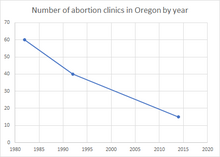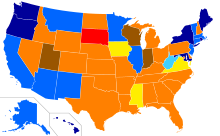Abortion In Oregon
Abortion in Oregon is legal.
The number of abortion clinics in Oregon has declined over the years, with sixty in 1982, forty in 1992 and fifteen in 2014. There were 8,231 legal abortions in 2014, and 8,610 in 2015.
Terminology
The abortion debate most commonly relates to the "induced abortion" of an embryo or fetus at some point in a pregnancy, which is also how the term is used in a legal sense. Some also use the term "elective abortion", which is used in relation to a claim to an unrestricted right of a woman to an abortion, whether or not she chooses to have one. The term elective abortion or voluntary abortion describes the interruption of pregnancy before viability at the request of the woman, but not for medical reasons.
Anti-abortion advocates tend to use terms such as "unborn baby", "unborn child", or "pre-born child", and see the medical terms "embryo", "zygote", and "fetus" as dehumanizing. Both "pro-choice" and "pro-life" are examples of terms labeled as political framing: they are terms which purposely try to define their philosophies in the best possible light, while by definition attempting to describe their opposition in the worst possible light. "Pro-choice" implies that the alternative viewpoint is "anti-choice", while "pro-life" implies the alternative viewpoint is "pro-death" or "anti-life". The Associated Press encourages journalists to use the terms "abortion rights" and "anti-abortion".
Context
Free birth control correlates to teenage girls having a fewer pregnancies and fewer abortions. A 2014 New England Journal of Medicine study found such a link. At the same time, a 2011 study by Center for Reproductive Rights and Ibis Reproductive Health also found that states with more abortion restrictions have higher rates of maternal death, higher rates of uninsured pregnant women, higher rates of infant and child deaths, higher rates of teen drug and alcohol abuse, and lower rates of cancer screening.
According to a 2017 report from the Center for Reproductive Rights and Ibis Reproductive Health, states that tried to pass additional constraints on a women's ability to access legal abortions had fewer policies supporting women's health, maternal health and children's health. These states also tended to resist expanding Medicaid, family leave, medical leave, and sex education in public schools. According to Megan Donovan, a senior policy manager at the Guttmacher Institute, states have legislation seeking to protect a woman's right to access abortion services have the lowest rates of infant mortality in the United States.
Poor women in the United States had problems paying for menstrual pads and tampons in 2018 and 2019. Almost two-thirds of American women could not pay for them. These were not available through the federal Women, Infants, and Children Program (WIC). Lack of menstrual supplies has an economic impact on poor women. A study in St. Louis found that 36% had to miss days of work because they lacked adequate menstrual hygiene supplies during their period. This was on top of the fact that many had other menstrual issues including bleeding, cramps and other menstrual induced health issues. As of November 2018, Oregon did not have a state sales tax and so menstrual items were not taxed.
History
The parents of Becky Bell worked with the Feminist Majority Foundation in the 1990s, which credited them with helping to turn public opinion against a parental-notification law in Oregon.
Legislative history
In the late 1960s and early 1970s, Arkansas, Colorado, Georgia, Maryland, New Mexico, North Carolina and Oregon made reforms to their abortion laws, with most of these states providing more detailed medical guidance on when therapeutic abortions could be performed.
In 1962, the American Law Institute published their model penal code as it applied to abortions with three circumstances where they believed a physician could justifiably perform an abortion, "If ... there is substantial risk that the continuance of the pregnancy would gravely impair the physical or mental health of the mother or that the child would be born with grave physical or mental defect, or that the pregnancy resulted from rape, incest, or other felonious intercourse."Versions of this model were passed into law in many states during the late 1960s and early 1970s. Oregon was an exception in that they chose to model their law in 1970 after the British Abortion Act of 1967. State law in 1971 required that any woman getting a legal abortion in the state needed to be a resident for some specific period between 30 and 90 days.
As of 2017, California, Oregon, Montana, Vermont, and New Hampshire allow qualified non-physician health professionals, such as physicians' assistants, nurse practitioners, and certified nurse midwives, to do first-trimester aspiration abortions and to prescribe drugs for medical abortions. Reproductive Health Equity Act was passed in 2017. The law required health insurance to offer abortion coverage and to absorb most of the costs for the procedure instead of passing them along to women. In August 2018, the state had a law to protect the right to have an abortion. As of May 2019, Oregon was the only state in the nation that had no legal restrictions on abortion.
Ballot box history
There was a ballot box measure in 2018 that sought to limit the ability of the state to use public funds to pay for abortions. This was rejected by voters.
Judicial history
The US Supreme Court's decision in 1973's Roe v. Wade ruling meant the state could no longer regulate abortion in the first trimester.
Clinic history

Between 1982 and 1992, the number of abortion clinics in the state decreased by twenty, going from sixty in 1982 to forty in 1992. In 2014, there were fifteen abortion clinics in the state. In 2014, 78% of the counties in the state did not have an abortion clinic. That year, 30% of women in the state aged 15 – 44 lived in a county without an abortion clinic. In March 2016, there were 12 Planned Parenthood clinics in the state. In 2017, there were 12 Planned Parenthood clinics in a state with a population of 911,617 women aged 15 – 49 of which 8 offered abortion services. That year, 30% of women in the state aged 15 – 44 lived in a county without an abortion clinic.
Statistics
In the period between 1972 and 1974, there was only 0 recorded illegal abortion death in the state. In 1990, 332,000 women in the state faced the risk of an unintended pregnancy. In 2013, among white women aged 15–19, there were abortions 760, 60 abortions for black women aged 15–19, 140 abortions for Hispanic women aged 15–19, and 70 abortions for women of all other races. In 2014, 63% of adults said in a poll by the Pew Research Center that abortion should be legal in all or most cases. In 2017, the state had an infant mortality rate of 5.4 deaths per 1,000 live births.
| Census division and state | Number | Rate | % change 1992–1996 | ||||
|---|---|---|---|---|---|---|---|
| 1992 | 1995 | 1996 | 1992 | 1995 | 1996 | ||
| US Total | 1,528,930 | 1,363,690 | 1,365,730 | 25.9 | 22.9 | 22.9 | –12 |
| Pacific | 368,040 | 290,520 | 288,190 | 38.7 | 30.5 | 30.1 | –22 |
| Alaska | 2,370 | 1,990 | 2,040 | 16.5 | 14.2 | 14.6 | –11 |
| California | 304,230 | 240,240 | 237,830 | 42.1 | 33.4 | 33 | –22 |
| Hawaii | 12,190 | 7,510 | 6,930 | 46 | 29.3 | 27.3 | –41 |
| Oregon | 16,060 | 15,590 | 15,050 | 23.9 | 22.6 | 21.6 | –10 |
| Washington | 33,190 | 25,190 | 26,340 | 27.7 | 20.2 | 20.9 | –24 |
| Location | Residence | Occurrence | % obtained by
out-of-state residents |
Year | Ref | ||||
|---|---|---|---|---|---|---|---|---|---|
| No. | Rate^ | Ratio^^ | No. | Rate^ | Ratio^^ | ||||
| Oregon | 7,683 | 9.9 | 169 | 8,231 | 10.6 | 181 | 9.6 | 2014 | |
| Oregon | 7,847 | 10 | 172 | 8,610 | 10.9 | 189 | 11.2 | 2015 | |
| Oregon | 8,230 | 10.3 | 181 | 8,942 | 11.2 | 196 | 10.6 | 2016 | |
| ^number of abortions per 1,000 women aged 15–44; ^^number of abortions per 1,000 live births | |||||||||
Abortion financing

17 states including Oregon used their own funds to cover all or most "medically necessary" abortions sought by low-income women under Medicaid, thirteen of which are required by State court orders to do so. In 2010, the state had 3,427 publicly funded abortions, of which were zero federally funded and 3,427 were state funded.
Abortion rights views and activities


Protests
Women from the state participated in marches supporting abortion rights as part of a #StoptheBans movement in May 2019.
Anti-abortion views and activities
The first clinic arson occurred in Oregon in March 1976 and the first bombing occurred in February 1978 in Ohio. The attack took place at a Planned Parenthood clinic in Eugene and was committed by an individual.
Rachelle "Shelley" Shannon attempted to set fires at abortion clinics in Oregon, California, Idaho and Nevada during the late 1980s and early 1990s and eventually plead guilty for these cases of arson. In 1993, she would be found guilty of attempted murder of Dr. George Tiller in 1993 at his Wichita, Kansas clinic.
Footnotes
- ^ According to the Supreme Court's decision in Roe v. Wade:
Likewise, Black's Law Dictionary defines abortion as "knowing destruction" or "intentional expulsion or removal".(a) For the stage prior to approximately the end of the first trimester, the abortion decision and its effectuation must be left to the medical judgement of the pregnant woman's attending physician. (b) For the stage subsequent to approximately the end of the first trimester, the State, in promoting its interest in the health of the mother, may, if it chooses, regulate the abortion procedure in ways that are reasonably related to maternal health. (c) For the stage subsequent to viability, the State in promoting its interest in the potentiality of human life may, if it chooses, regulate, and even proscribe, abortion except where it is necessary, in appropriate medical judgement, for the preservation of the life or health of the mother.